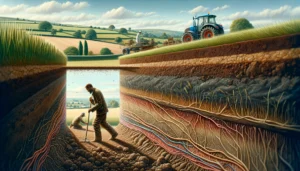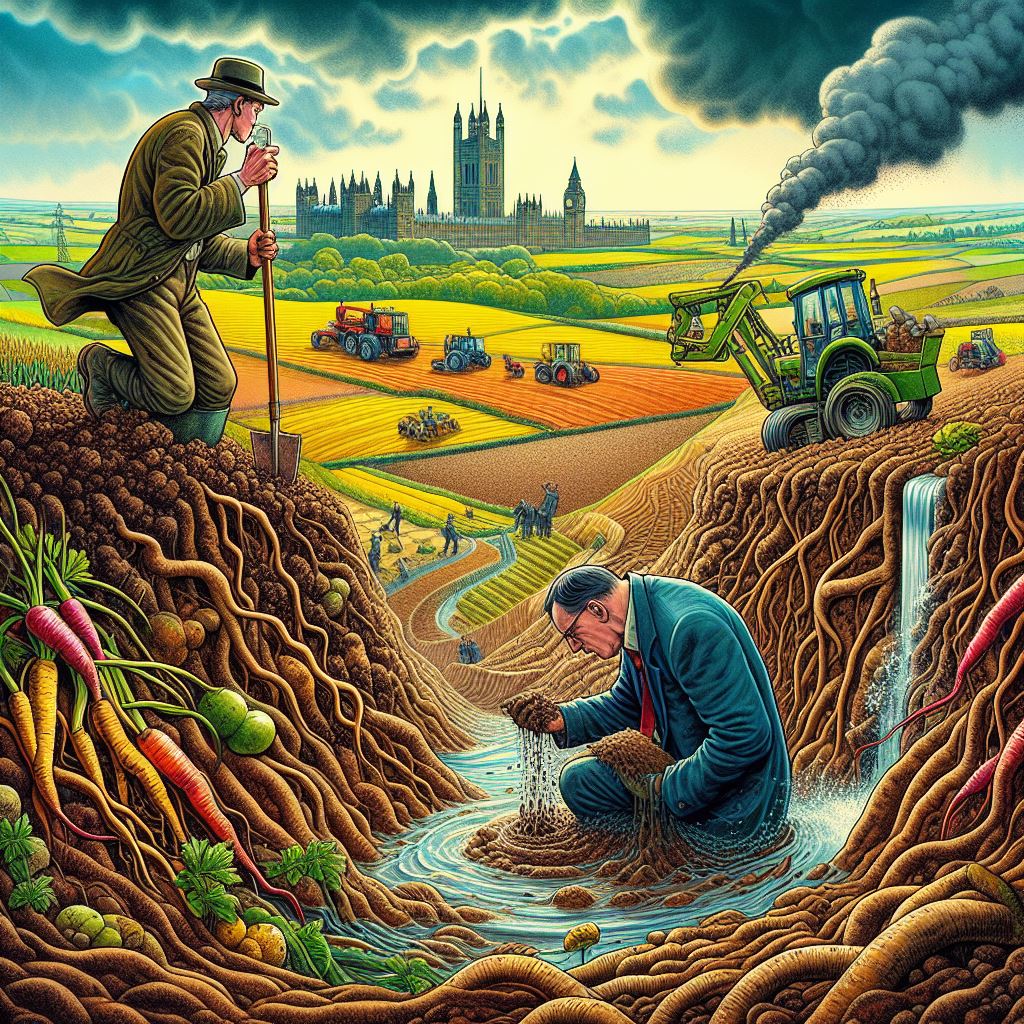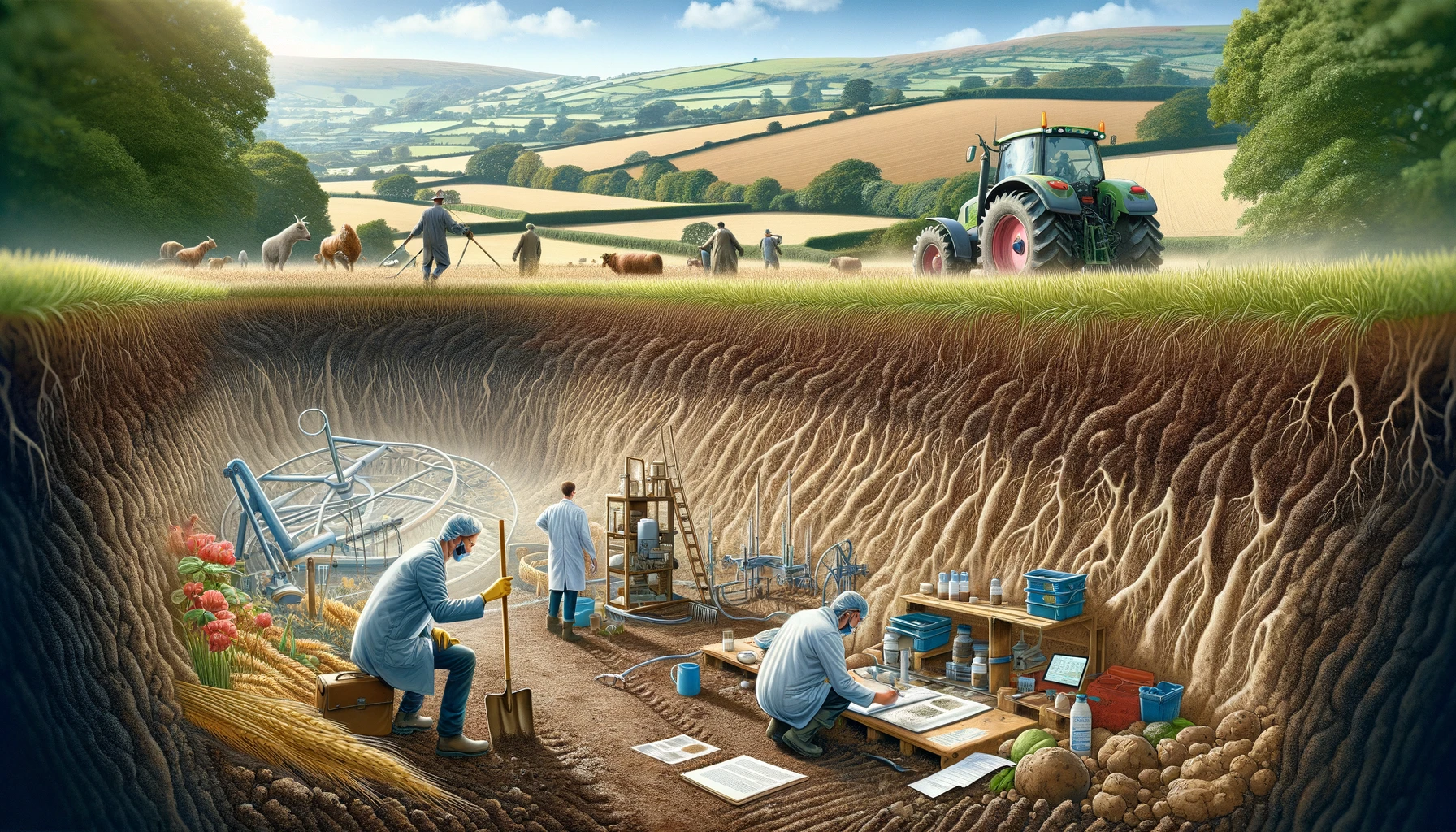Comprehensive Guide to Tilth and Soil Science for Farmers in the UK
Soil health and structure are critical components of successful farming, particularly in the United Kingdom where diverse soil types and climatic conditions present unique challenges and opportunities. This comprehensive guide delves into the concepts of tilth and soil science, offering UK farmers detailed insights, practical tips, and sustainable practices to optimize their soil management. The guide will cover the basics of soil science, the importance of tilth, soil testing, improvement practices, cost-effective solutions, and innovative techniques.
Understanding Soil Science
What is Soil Science?
Soil science is the study of soil as a natural resource on the surface of the Earth, including soil formation, classification, and mapping; physical, chemical, biological, and fertility properties of soils; and these properties in relation to the use and management of soils.
Components of Soil
- Mineral Content: Includes sand, silt, and clay, which influence the soil’s texture and fertility.
- Organic Matter: Decomposed plant and animal residues that contribute to soil fertility and structure.
- Water: Essential for plant growth and nutrient transport within the soil.
- Air: Soil aeration is crucial for root respiration and microbial activity.
- Microorganisms: Bacteria, fungi, and other microorganisms that decompose organic matter and contribute to nutrient cycling.
Soil Formation
Soil formation is a continuous process influenced by several factors:
- Parent Material: The original rock or mineral material from which the soil is formed.
- Climate: Temperature and precipitation affect soil development and organic matter decomposition.
- Topography: The landscape position influences drainage, erosion, and soil depth.
- Biological Factors: Plants, animals, and microorganisms contribute to soil formation through organic matter addition and bioturbation.
- Time: Soil formation is a slow process that can take hundreds to thousands of years.
Soil Types in the UK
- Chalky Soils: Found in areas like the South Downs, known for good drainage but low fertility.
- Clay Soils: Common in the Midlands and East Anglia, characterized by high nutrient content but poor drainage.
- Sandy Soils: Found in coastal areas, these soils drain well but retain fewer nutrients.
- Peaty Soils: High organic matter content, found in wetland areas like the Scottish Highlands.
- Loamy Soils: A balanced mixture of sand, silt, and clay, offering good fertility and drainage.
Importance of Tilth
What is Tilth?
Tilth refers to the physical condition of soil in relation to its suitability for planting and growing crops. Good tilth is characterized by soil that is loose, crumbly, and well-aerated, allowing for easy root penetration and water infiltration.
Benefits of Good Tilth
- Enhanced Root Growth: Loose soil structure facilitates root expansion and access to nutrients.
- Improved Water Infiltration and Retention: Well-structured soil allows water to penetrate easily and retain moisture.
- Reduced Erosion: Stable soil aggregates reduce the risk of erosion by wind and water.
- Increased Microbial Activity: Aerated soil supports beneficial microbial populations that aid in nutrient cycling and disease suppression.
Factors Affecting Tilth
- Soil Texture: The proportion of sand, silt, and clay affects soil structure and workability.
- Organic Matter: Higher organic matter content improves soil structure and tilth.
- Compaction: Soil compaction reduces tilth by limiting air and water movement.
- Moisture Content: Optimal moisture levels are crucial for maintaining good tilth.
Soil Testing and Analysis
Importance of Soil Testing
Soil testing provides essential information about soil fertility, pH levels, and nutrient availability, helping farmers make informed decisions about fertilization and soil management.
Soil Sampling Methods
- Grid Sampling: Dividing the field into a grid and taking samples from each grid point.
- Zone Sampling: Sampling based on different management zones within a field, such as soil type or crop yield.
- Composite Sampling: Mixing multiple samples from a field to create a single representative sample.
Key Soil Tests
- pH Test: Measures soil acidity or alkalinity, influencing nutrient availability.
- Nutrient Analysis: Determines the levels of essential nutrients like nitrogen, phosphorus, potassium, calcium, and magnesium.
- Organic Matter Content: Indicates the amount of decomposed plant and animal material in the soil.
- Cation Exchange Capacity (CEC): Measures the soil’s ability to hold and exchange nutrients.
- Soil Texture Analysis: Determines the proportions of sand, silt, and clay in the soil.
Interpreting Soil Test Results
- pH Levels: Aim for a pH between 6.0 and 7.5 for most crops. Adjust with lime to raise pH or sulfur to lower pH.
- Nutrient Levels: Identify deficiencies and apply appropriate fertilizers to correct them.
- Organic Matter: Maintain or increase organic matter levels to improve soil health.
- CEC: Higher CEC indicates better nutrient-holding capacity.
Improving Soil Tilth and Health
Organic Matter Management
- Composting: Apply compost to increase organic matter, improve soil structure, and add nutrients.
- Green Manure: Grow and incorporate cover crops like clover or rye to add organic matter and nitrogen.
- Mulching: Use organic mulches like straw or wood chips to protect soil, retain moisture, and add organic matter as they decompose.
Cover Cropping
- Benefits: Cover crops protect soil from erosion, improve soil structure, and add organic matter.
- Types of Cover Crops: Legumes (e.g., clover, vetch) add nitrogen, while grasses (e.g., rye, oats) improve soil structure.
- Management: Plant cover crops during fallow periods and incorporate them into the soil before planting the main crop.
Crop Rotation
- Benefits: Crop rotation breaks pest and disease cycles, improves soil fertility, and enhances soil structure.
- Planning: Rotate crops with different root structures and nutrient requirements to maintain soil health.
- Examples: Rotate legumes (e.g., beans, peas) with cereals (e.g., wheat, barley) and root crops (e.g., potatoes, carrots).
Reduced Tillage Practices
- No-Till Farming: Avoids soil disturbance, preserving soil structure and organic matter.
- Reduced Tillage: Minimizes soil disturbance by using shallow tillage methods.
- Benefits: Reduced erosion, improved water retention, and enhanced soil microbial activity.
Soil Amendments
- Lime: Raises soil pH and supplies calcium and magnesium.
- Gypsum: Improves soil structure, particularly in clay soils, and adds calcium and sulfur.
- Organic Fertilizers: Use compost, manure, and bone meal to add nutrients and organic matter.
Cost-Effective Solutions for Soil Management
Efficient Resource Management
- Bulk Purchasing: Buy soil amendments and fertilizers in bulk to reduce costs.
- Resource Sharing: Share equipment and resources with neighboring farms to lower expenses.
- DIY Solutions: Create homemade compost and organic fertilizers to save money.
Low-Cost Technologies
- Soil Moisture Sensors: Use affordable soil moisture sensors to optimize irrigation and reduce water use.
- Organic Mulches: Use locally available organic materials like straw or wood chips as cost-effective mulches.
- Rainwater Harvesting: Collect and use rainwater for irrigation to save on water costs.
Energy Savings
- Energy-Efficient Equipment: Invest in energy-efficient machinery to reduce energy consumption and costs.
- Solar Power: Use solar panels to power irrigation systems and other farm equipment.
- LED Lighting: Replace traditional lighting with LED bulbs to save energy and reduce electricity bills.
Labor Optimization
- Seasonal Workers: Hire seasonal workers during peak periods to reduce labor costs.
- Training Programs: Invest in training programs for workers to improve efficiency and productivity.
- Mechanization: Use mechanized equipment for labor-intensive tasks to save time and reduce labor costs.
Innovative Techniques and Practices
Precision Agriculture
- GPS and GIS Mapping: Use GPS and GIS technology to create detailed maps of fields, allowing for precise application of inputs.
- Variable Rate Technology (VRT): Utilize VRT to apply fertilizers, pesticides, and irrigation at variable rates, optimizing resource use.
- Drones: Employ drones for aerial surveys to assess crop health, identify pest infestations, and monitor field conditions.
Smart Irrigation Systems
- Drip Irrigation: Implement drip irrigation systems to deliver water directly to the root zone, reducing water waste.
- Automated Irrigation: Use automated irrigation systems controlled by soil moisture sensors and weather forecasts to ensure optimal watering schedules.
- Water Conservation Techniques: Employ mulching and cover cropping to retain soil moisture and reduce irrigation needs.
Data-Driven Decision Making
- Farm Management Software: Use farm management software to track inputs, monitor crop performance, and manage finances.
- Yield Mapping: Analyze yield data to identify patterns and variations within fields, making adjustments to improve future yields.
- Weather Monitoring: Subscribe to advanced weather monitoring services to receive accurate forecasts and alerts, helping plan activities like planting and harvesting.
Renewable Energy
- Solar Power: Install solar panels to generate electricity for farm operations, reducing reliance on fossil fuels.
- Wind Turbines: Use small wind turbines to harness wind energy, providing an additional renewable energy source.
- Bioenergy: Convert agricultural waste into bioenergy through anaerobic digestion or biomass combustion.
Practical Tips for Soil Management
Regular Monitoring
- Soil Testing: Conduct regular soil tests to monitor pH, nutrient levels, and organic matter content.
- Visual Inspections: Perform visual inspections of soil structure, compaction, and erosion.
- Record Keeping: Maintain detailed records of soil test results, amendments applied, and crop performance.
Balanced Nutrition
- Soil Amendments: Apply soil amendments based on soil test results to maintain optimal nutrient levels and pH.
- Organic Fertilizers: Use organic fertilizers like compost, manure, and bone meal to add nutrients and improve soil health.
- Nutrient Management Plans: Develop and follow nutrient management plans to ensure balanced fertilization and avoid over-application.
Water Management
- Efficient Irrigation: Use efficient irrigation systems like drip or micro-sprinklers to conserve water.
- Soil Moisture Monitoring: Use soil moisture sensors to optimize irrigation schedules and avoid overwatering.
- Water Conservation Techniques: Employ mulching and cover cropping to retain soil moisture and reduce irrigation needs.
Erosion Control
- Cover Cropping: Plant cover crops to protect soil from erosion and improve soil structure.
- Contour Farming: Use contour farming techniques to reduce soil erosion on slopes.
- Buffer Strips: Establish buffer strips of vegetation along field edges to reduce runoff and capture sediment.
Disease Prevention
- Crop Rotation: Rotate crops to break pest and disease cycles and improve soil health.
- Resistant Varieties: Plant disease-resistant crop varieties to minimize the need for chemical treatments.
- Sanitation: Practice good farm hygiene by regularly cleaning equipment, tools, and storage areas to prevent disease spread.
Harvest Optimization
- Timely Harvesting: Harvest crops at the optimal stage of ripeness to ensure peak quality and yield.
- Proper Storage: Store harvested produce in appropriate conditions to extend shelf life and prevent spoilage.
Expert Advice for Farmers
Pest and Disease Management
- Integrated Pest Management (IPM): Use a combination of biological, cultural, and mechanical methods to manage pests and diseases.
- Biological Controls: Introduce beneficial insects and natural predators to control pest populations naturally.
- Cultural Practices: Implement cultural practices like crop rotation, intercropping, and planting resistant varieties to manage pests and diseases.
Soil Health
- Organic Matter: Increase soil organic matter through cover cropping, composting, and reduced tillage practices.
- Soil Amendments: Use soil amendments like lime or gypsum to correct soil pH and improve structure.
- Microbial Activity: Encourage beneficial microbial activity by maintaining adequate soil moisture and organic matter levels.
Crop Selection
- Climate Suitability: Choose crops that are well-suited to your local climate and growing conditions.
- Market Demand: Select crops with high market demand to ensure profitability.
- Diversity: Diversify crop selection to reduce risk and improve soil health.
Sustainable Practices
- Water Conservation: Implement water-saving techniques like drip irrigation and mulching to conserve water.
- Renewable Energy: Use renewable energy sources like solar and wind to power farm operations.
- Reduced Tillage: Practice reduced or no-till farming to preserve soil structure and organic matter.
Financial Management
- Budgeting: Create a detailed budget to track expenses and manage finances effectively.
- Cost-Benefit Analysis: Perform cost-benefit analyses for major investments to ensure they are financially viable.
- Diversified Income: Diversify income streams by exploring value-added products, agri-tourism, and other opportunities.
Insider Secrets for Farmers
Enhancing Crop Quality
- Thinning: Thin excess plants to improve crop size, quality, and yield.
- Pruning: Regularly prune fruit trees and bushes to promote healthy growth and increase fruit production.
- Soil Amendments: Use soil amendments like compost and organic fertilizers to enhance soil fertility and crop quality.
Extending Growing Season
- High Tunnels: Use high tunnels or hoop houses to extend the growing season and protect crops from adverse weather.
- Cold Frames: Build cold frames to start seedlings earlier and extend the harvest season.
- Mulching: Apply organic mulches to retain soil moisture, regulate temperature, and suppress weeds.
Cost-Saving Measures
- Bulk Purchasing: Buy inputs like seeds, fertilizers, and pesticides in bulk to take advantage of discounts.
- Second-Hand Equipment: Purchase second-hand equipment to save money while maintaining functionality.
- Homemade Solutions: Create homemade compost, fertilizers, and pest control solutions to reduce costs.
Labor Management
- Efficient Labor Use: Schedule labor-intensive tasks during cooler parts of the day to improve worker productivity and comfort.
- Seasonal Workers: Hire seasonal workers for peak periods to reduce labor costs and ensure timely completion of tasks.
- Mechanization: Use mechanized equipment for labor-intensive tasks to save time and reduce labor costs.
Soil Health Practices
- Cover Cropping: Use cover crops to improve soil fertility, structure, and water retention.
- Composting: Incorporate compost into the soil to provide a slow-release source of nutrients and improve soil health.
- Reduced Tillage: Practice reduced or no-till farming to preserve soil structure and organic matter.
Practical Examples and Case Studies
Case Study 1: Sustainable Soil Management
Location: Green Valley Farm, England
Practices:
- Soil Health: Green Valley Farm uses cover crops and compost to improve soil fertility and structure. Annual soil tests guide their fertilization program.
- Pest Management: The farm employs an integrated pest management (IPM) approach, using beneficial insects and natural predators to control pests. Regular scouting helps identify issues early.
- Water Conservation: Drip irrigation and rainwater harvesting reduce water use and costs. Mulching helps retain soil moisture and suppress weeds.
- Marketing: Green Valley Farm sells directly to consumers through a CSA program and farmers’ markets. They also produce value-added products like organic honey and herbal teas.
Outcomes: Green Valley Farm has achieved high crop quality, reduced input costs, and increased profitability through sustainable practices.
Case Study 2: Innovative Soil Management Practices
Location: Sunshine Farms, Wales
Practices:
- Water-Saving Techniques: Sunshine Farms implemented a precision drip irrigation system, reducing water use by 30%. Soil moisture sensors help optimize irrigation schedules.
- Rainwater Harvesting: The farm collects and stores rainwater for irrigation, reducing reliance on municipal water sources and lowering utility bills.
- Energy Efficiency: Solar panels power the irrigation system and cold storage units, reducing energy costs.
Outcomes: Sunshine Farms has significantly reduced water and energy costs while maintaining high crop quality and yield.
Case Study 3: Integrated Soil Management
Location: Eco-Farms, Scotland
Practices:
- Organic Fertilizers: Eco-Farms uses compost, fish emulsion, and bone meal to provide nutrients. Soil tests guide their fertilization program.
- Natural Pest Control: The farm uses neem oil, insecticidal soap, and beneficial insects to manage pests. Crop rotation and cover crops reduce disease pressure.
- Sustainable Practices: Eco-Farms practices crop rotation, cover cropping, and mulching to improve soil health and reduce erosion.
Outcomes: Eco-Farms has achieved organic certification, reduced input costs, and increased market demand for their organic products.
Conclusion
Understanding and managing tilth and soil science is essential for successful farming in the UK. By implementing the tips, expert advice, cost-effective solutions, and innovative practices outlined in this guide, UK farmers can optimize their soil management, enhance productivity, and increase profitability. Remember to stay informed, adapt to changing conditions, and continuously seek new ways to improve your farming practices. With the right approach, you can ensure the health and sustainability of your soil, leading to a prosperous farming future.
Tilth Image Gallery







